Dawei Wang
Optimizing Efficiency of Mixed Traffic through Reinforcement Learning: A Topology-Independent Approach and Benchmark
Jan 28, 2025



Abstract:This paper presents a mixed traffic control policy designed to optimize traffic efficiency across diverse road topologies, addressing issues of congestion prevalent in urban environments. A model-free reinforcement learning (RL) approach is developed to manage large-scale traffic flow, using data collected by autonomous vehicles to influence human-driven vehicles. A real-world mixed traffic control benchmark is also released, which includes 444 scenarios from 20 countries, representing a wide geographic distribution and covering a variety of scenarios and road topologies. This benchmark serves as a foundation for future research, providing a realistic simulation environment for the development of effective policies. Comprehensive experiments demonstrate the effectiveness and adaptability of the proposed method, achieving better performance than existing traffic control methods in both intersection and roundabout scenarios. To the best of our knowledge, this is the first project to introduce a real-world complex scenarios mixed traffic control benchmark. Videos and code of our work are available at https://sites.google.com/berkeley.edu/mixedtrafficplus/home
Learning to Change: Choreographing Mixed Traffic Through Lateral Control and Hierarchical Reinforcement Learning
Mar 21, 2024



Abstract:The management of mixed traffic that consists of robot vehicles (RVs) and human-driven vehicles (HVs) at complex intersections presents a multifaceted challenge. Traditional signal controls often struggle to adapt to dynamic traffic conditions and heterogeneous vehicle types. Recent advancements have turned to strategies based on reinforcement learning (RL), leveraging its model-free nature, real-time operation, and generalizability over different scenarios. We introduce a hierarchical RL framework to manage mixed traffic through precise longitudinal and lateral control of RVs. Our proposed hierarchical framework combines the state-of-the-art mixed traffic control algorithm as a high level decision maker to improve the performance and robustness of the whole system. Our experiments demonstrate that the framework can reduce the average waiting time by up to 54% compared to the state-of-the-art mixed traffic control method. When the RV penetration rate exceeds 60%, our technique consistently outperforms conventional traffic signal control programs in terms of the average waiting time for all vehicles at the intersection.
GaussianGrasper: 3D Language Gaussian Splatting for Open-vocabulary Robotic Grasping
Mar 14, 2024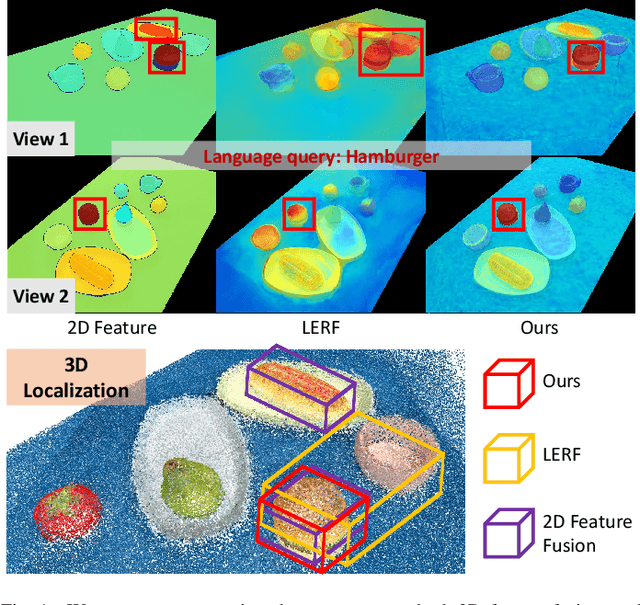
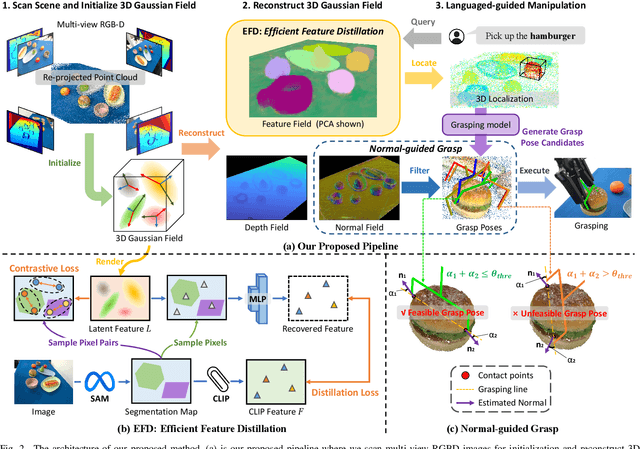
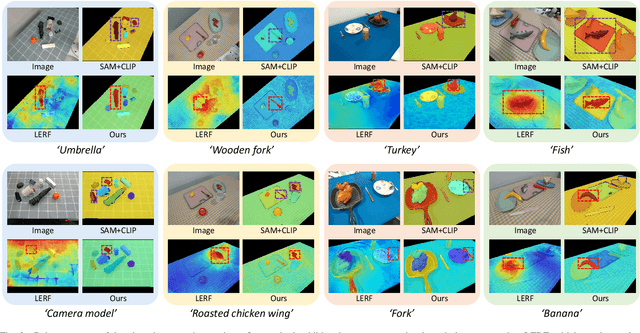
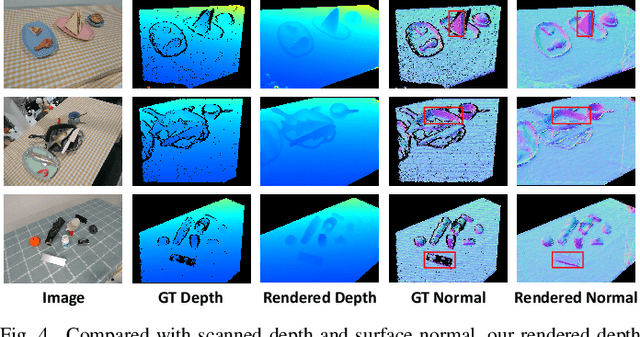
Abstract:Constructing a 3D scene capable of accommodating open-ended language queries, is a pivotal pursuit, particularly within the domain of robotics. Such technology facilitates robots in executing object manipulations based on human language directives. To tackle this challenge, some research efforts have been dedicated to the development of language-embedded implicit fields. However, implicit fields (e.g. NeRF) encounter limitations due to the necessity of processing a large number of input views for reconstruction, coupled with their inherent inefficiencies in inference. Thus, we present the GaussianGrasper, which utilizes 3D Gaussian Splatting to explicitly represent the scene as a collection of Gaussian primitives. Our approach takes a limited set of RGB-D views and employs a tile-based splatting technique to create a feature field. In particular, we propose an Efficient Feature Distillation (EFD) module that employs contrastive learning to efficiently and accurately distill language embeddings derived from foundational models. With the reconstructed geometry of the Gaussian field, our method enables the pre-trained grasping model to generate collision-free grasp pose candidates. Furthermore, we propose a normal-guided grasp module to select the best grasp pose. Through comprehensive real-world experiments, we demonstrate that GaussianGrasper enables robots to accurately query and grasp objects with language instructions, providing a new solution for language-guided manipulation tasks. Data and codes can be available at https://github.com/MrSecant/GaussianGrasper.
Analyzing Emissions and Energy Efficiency in Mixed Traffic Control at Unsignalized Intersections
Nov 20, 2023Abstract:Greenhouse gas emissions have dramatically risen since the early 1900s with U.S. transportation generating 28% of the U.S' emissions. As such, there is interest in reducing transportation-related emissions. Specifically, sustainability research has sprouted around signalized intersections as intersections allow different streams of traffic to cross and change directions. Recent research has developed mixed traffic control eco-driving strategies at signalized intersections to decrease emissions. However, the inherent structure of a signalized intersection generates increased emissions by creating frequent acceleration/deceleration events, excessive idling from traffic congestion, and stop-and-go waves. Thus, we believe unsignalized intersections hold potential for further sustainability improvements. In this work, we provide an emissions analysis on unsignalized intersections with complex, real-world topologies and traffic demands where mixed traffic control strategies are employed by robot vehicles (RVs) to reduce waiting times and congestion. We find with at least 10% RV penetration rate, RVs generate less fuel consumption and NOx emissions than signalized intersections by up to 27% and 28%, respectively. With at least 30% RVs, CO and HC emissions are reduced by up to 42% and 43%, respectively. Additionally, RVs can reduce emissions across the whole network despite only employing their strategies at the intersections.
Large-scale Mixed Traffic Control Using Dynamic Vehicle Routing and Privacy-Preserving Crowdsourcing
Nov 19, 2023Abstract:Controlling and coordinating urban traffic flow through robot vehicles is emerging as a novel transportation paradigm for the future. While this approach garners growing attention from researchers and practitioners, effectively managing and coordinating large-scale mixed traffic remains a challenge. We introduce an effective framework for large-scale mixed traffic control via privacy-preserving crowdsourcing and dynamic vehicle routing. Our framework consists of three modules: a privacy-protecting crowdsensing method, a graph propagation-based traffic forecasting method, and a privacy-preserving route selection mechanism. We evaluate our framework using a real-world road network. The results show that our framework accurately forecasts traffic flow, efficiently mitigates network-wide RV shortage issue, and coordinates large-scale mixed traffic. Compared to other baseline methods, our framework not only reduces the RV shortage issue up to 69.4% but also reduces the average waiting time of all vehicles in the network up to 27%.
Model2Scene: Learning 3D Scene Representation via Contrastive Language-CAD Models Pre-training
Sep 29, 2023Abstract:Current successful methods of 3D scene perception rely on the large-scale annotated point cloud, which is tedious and expensive to acquire. In this paper, we propose Model2Scene, a novel paradigm that learns free 3D scene representation from Computer-Aided Design (CAD) models and languages. The main challenges are the domain gaps between the CAD models and the real scene's objects, including model-to-scene (from a single model to the scene) and synthetic-to-real (from synthetic model to real scene's object). To handle the above challenges, Model2Scene first simulates a crowded scene by mixing data-augmented CAD models. Next, we propose a novel feature regularization operation, termed Deep Convex-hull Regularization (DCR), to project point features into a unified convex hull space, reducing the domain gap. Ultimately, we impose contrastive loss on language embedding and the point features of CAD models to pre-train the 3D network. Extensive experiments verify the learned 3D scene representation is beneficial for various downstream tasks, including label-free 3D object salient detection, label-efficient 3D scene perception and zero-shot 3D semantic segmentation. Notably, Model2Scene yields impressive label-free 3D object salient detection with an average mAP of 46.08\% and 55.49\% on the ScanNet and S3DIS datasets, respectively. The code will be publicly available.
Learning to Control and Coordinate Hybrid Traffic Through Robot Vehicles at Complex and Unsignalized Intersections
Jan 12, 2023Abstract:Intersections are essential road infrastructures for traffic in modern metropolises; however, they can also be the bottleneck of traffic flows due to traffic incidents or the absence of traffic coordination mechanisms such as traffic lights. Thus, various control and coordination mechanisms that are beyond traditional control methods have been proposed to improve the efficiency of intersection traffic. Amongst these methods, the control of foreseeable hybrid traffic that consists of human-driven vehicles (HVs) and robot vehicles (RVs) has recently emerged. We propose a decentralized reinforcement learning approach for the control and coordination of hybrid traffic at real-world, complex intersections--a topic that has not been previously explored. Comprehensive experiments are conducted to show the effectiveness of our approach. In particular, we show that using 5% RVs, we can prevent congestion formation inside the intersection under the actual traffic demand of 700 vehicles per hour. In contrast, without RVs, congestion starts to develop when the traffic demand reaches as low as 200 vehicles per hour. Further performance gains (reduced waiting time of vehicles at the intersection) are obtained as the RV penetration rate increases. When there exist more than 50% RVs in traffic, our method starts to outperform traffic signals on the average waiting time of all vehicles at the intersection. Our method is also robust against both blackout events and sudden RV percentage drops, and enjoys excellent generalizablility, which is illustrated by its successful deployment in two unseen intersections.
Deep Anomaly Detection and Search via Reinforcement Learning
Aug 31, 2022

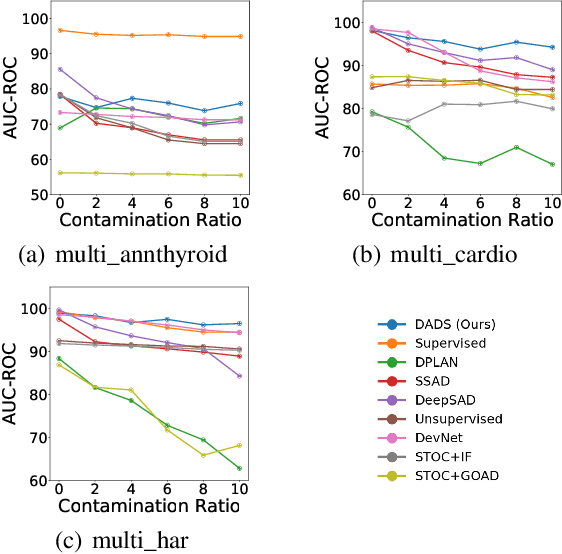

Abstract:Semi-supervised Anomaly Detection (AD) is a kind of data mining task which aims at learning features from partially-labeled datasets to help detect outliers. In this paper, we classify existing semi-supervised AD methods into two categories: unsupervised-based and supervised-based, and point out that most of them suffer from insufficient exploitation of labeled data and under-exploration of unlabeled data. To tackle these problems, we propose Deep Anomaly Detection and Search (DADS), which applies Reinforcement Learning (RL) to balance exploitation and exploration. During the training process, the agent searches for possible anomalies with hierarchically-structured datasets and uses the searched anomalies to enhance performance, which in essence draws lessons from the idea of ensemble learning. Experimentally, we compare DADS with several state-of-the-art methods in the settings of leveraging labeled known anomalies to detect both other known anomalies and unknown anomalies. Results show that DADS can efficiently and precisely search anomalies from unlabeled data and learn from them, thus achieving good performance.
CD and PMD Effect on Cyclostationarity-Based Timing Recovery for Optical Coherent Receivers
Aug 30, 2022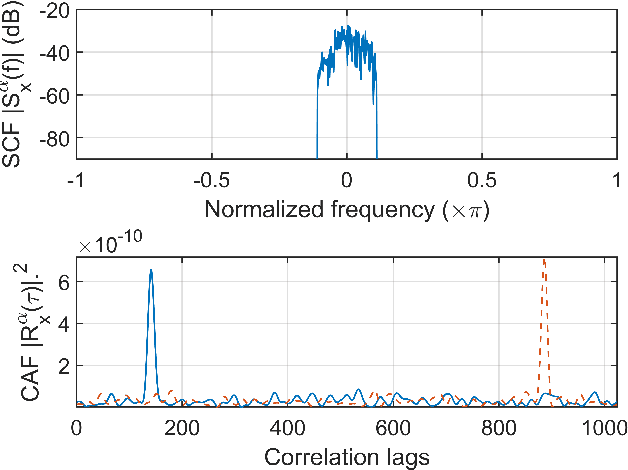

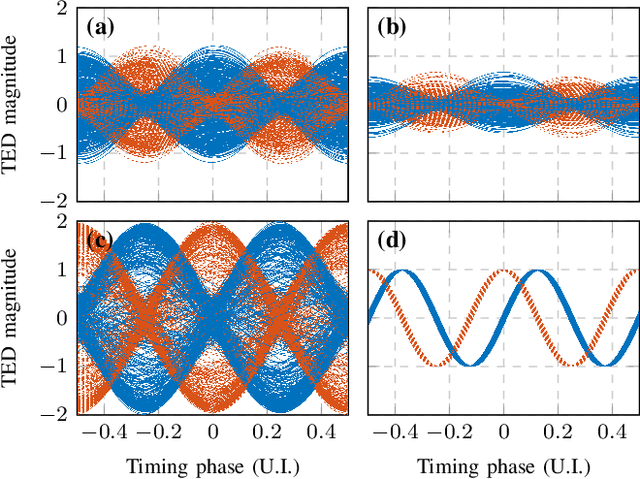

Abstract:Timing recovery is critical for synchronizing the clocks at the transmitting and receiving ends of a digital coherent communication system. The core of timing recovery is to determine reliably the current sampling error of the local digitizer so that the timing circuit may lock to a stable operation point. Conventional timing phase detectors need to adapt to the optical fiber channel so that the common effects of this channel, such as chromatic dispersion (CD) and polarization mode dispersion (PMD), on the timing phase extraction must be understood. Here we exploit the cyclostationarity of the optical signal and derive a model for studying the CD and PMD effect. We prove that the CD-adjusted cyclic correlation matrix contains full information about timing and PMD, and the determinant of the matrix is a timing phase detector immune to both CD and PMD. We also obtain other results such as a completely PMD-independent CD estimator, etc. Our analysis is supported by both simulations and experiments over a field implemented optical cable.
Jacobian Methods for Dynamic Polarization Control in Optical Applications
Aug 29, 2022



Abstract:Dynamic polarization control (DPC) is beneficial for many optical applications. It uses adjustable waveplates to perform automatic polarization tracking and manipulation. Efficient algorithms are essential to realizing an endless polarization control process at high speed. However, the standard gradientbased algorithm is not well analyzed. Here we model the DPC with a Jacobian-based control theory framework that finds a lot in common with robot kinematics. We then give a detailed analysis of the condition of the Stokes vector gradient as a Jacobian matrix. We identify the multi-stage DPC as a redundant system enabling control algorithms with null-space operations. An efficient, reset-free algorithm can be found. We anticipate more customized DPC algorithms to follow the same framework in various optical systems.
 Add to Chrome
Add to Chrome Add to Firefox
Add to Firefox Add to Edge
Add to Edge